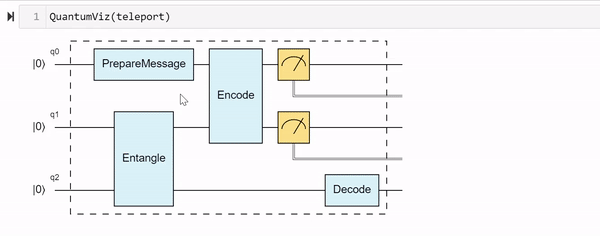quantum-viz is the Python package companion of quantum-viz.js, a JavaScript package that supports visualizing any arbitrary quantum gate, classical control logic and collapsed grouped blocks of gates using JSON-formatted input data. quantum-viz contains a Jupyter widget and will also include support for translating quantum circuits written in common quantum programming libraries to JSON using the quantum-viz.js JSON schema.
You can install the quantum-viz.js widget via pip from PyPI:
pip install quantum-vizTo use the quantum-viz widget, run the below example code in a Jupyter notebook cell:
from quantum_viz import Viewer
# Create a quantum circuit that prepares a Bell state
circuit = {
"qubits": [{ "id": 0 }, { "id": 1, "numChildren": 1 }],
"operations": [
{
"gate": 'H',
"targets": [{ "qId": 0 }],
},
{
"gate": 'X',
"isControlled": "True",
"controls": [{ "qId": 0 }],
"targets": [{ "qId": 1 }],
},
{
"gate": 'Measure',
"isMeasurement": "True",
"controls": [{ "qId": 1 }],
"targets": [{ "type": 1, "qId": 1, "cId": 0 }],
},
],
}
widget = Viewer(circuit)
widget # Display the widgetBy installing the optional [qiskit] dependency, you can leverage Qiskit's QuantumCircuit APIs
to define the circuit and render it using the Viewer widget on Jupyter, for example:
from qiskit import QuantumRegister, ClassicalRegister, QuantumCircuit
from quantum_viz import Viewer
qr = QuantumRegister(3, 'q')
anc = QuantumRegister(1, 'ancilla')
cr = ClassicalRegister(3, 'c')
qc = QuantumCircuit(qr, anc, cr)
qc.h(qr[0:3])
qc.x(anc[0])
qc.h(anc[0])
qc.cx(qr[0:3], anc[0])
qc.h(qr[0:3])
qc.barrier(qr)
qc.measure(qr, cr)
Viewer(qc)Optionally, you can also import the display method from quantum_viz.utils to render the circuit on a new browser window:
from quantum_viz.utils import display
display(qc)Check out our contributing guidelines to find out how you can contribute to quantum-viz.
